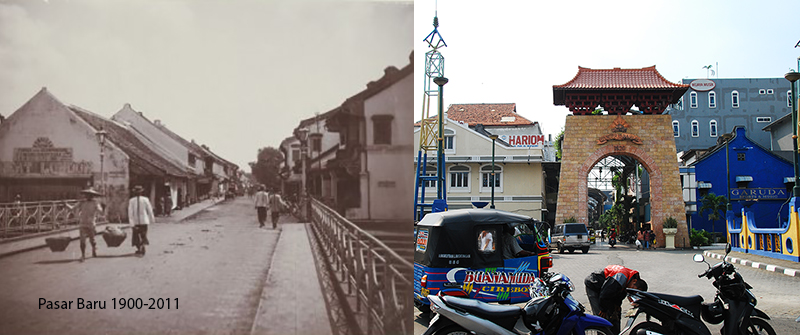
05 Jul Blog: Stepping into the surreal
Walking through the entrance gate to the shopping street ‘Pasar Baru’, Jakarta, was like stepping into my favourite movie, says Jemma Middleton.
I recognised the different shops, the old and new architecture, the way a shopkeeper was advertising ‘diskont’ through a microphone and I knew exactly where each side street would take me. I even had the feeling that I recognised street vendors. It was as though I was seeing an old friend I had known for years, but it felt as surreal as stepping into the fantasy world of Harry Potter: all of my ‘memories’ of this street had lived in my imagination since I had never been to Jakarta before April 2016.
My visual memory of Pasar Baru came from working with video footage, photos and maps dating from 1850 up to 2011 in the Recording the Future (RtF) archive and the digital media archive of the KITLV in Leiden, the Netherlands. During my six-month internship in 2013 I dug deep into the KITLV archive to find material that could be connected to RtF. In the end I zoomed in on Pasar Baru to see how it had changed in the past 150 years. So walking through the ‘pasar’ in April was like time travelling: seeing Toko Kompak, one of the oldest Chinese buildings with its facade of carved wood still visible, took me back to 1850, but a few metres further on I was rushed into the 21st century department store Matahari.
Knowing Indonesia audio-visually over time made this a very special trip. I had a three-dimensional, or maybe even four-dimensional, impression of Indonesia based on postcards, drawings, photos, maps, moving images, sounds and more, giving me a feeling of déjà vu on arriving on Java. Furthermore, when meeting up with my anthropologist friends from Leiden doing their master’s research in Jogja (Yogyakarta) I realised that I had far less of a culture shock than they did. During my travels on the island and Bali this celebration of recognition continued.
Adding to this recognition was the sense of ‘makeshift’ that Kloos talks about in his article in Visual Anthropology Review when analysing RtF video-footage. Seeing old houses with new façades or temporary-looking street restaurants, and hearing stories of mobility across Indonesia, I understood how people were living their everyday lives through improvised practices. In Bali you can see this makeshift reality very clearly, as the tourist influxes influence where large numbers of the Balinese find work. It was very normal for Ketut, a taxi driver who lived in the north of the island, to drive to Denpasar airport from home, pick me up and drive me to Ubud, after which he would find someone else to drive from Ubud to the next location. This shows how people are willing to be flexible to ensure their livelihood.
For me already having ‘been to Indonesia’ with RtF and the KITLV was the surreal cherry on top of my time in the country.
(Jemma Middleton studies Cultural Anthropology at Leiden University. In 2013 she was internee at the Recording the Future project.)




No Comments